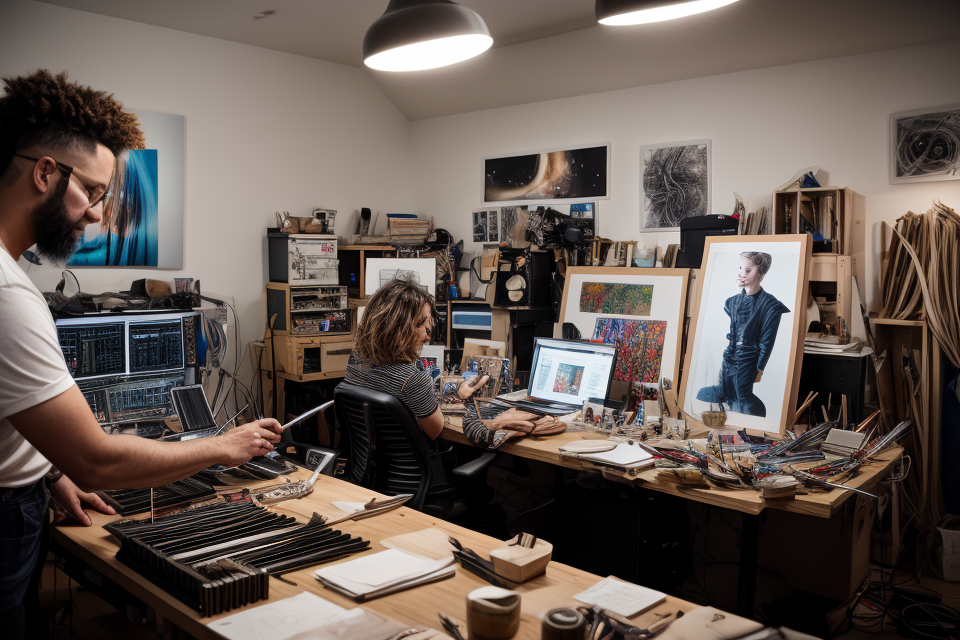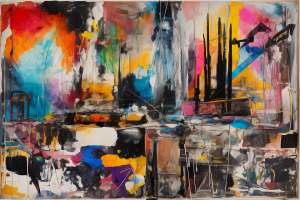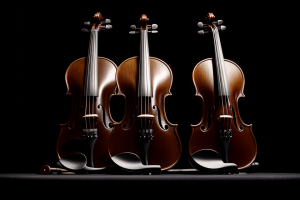
Art is a medium of expression, a way for artists to convey their thoughts, emotions, and perceptions to the world. The choices that artists make regarding materials and techniques play a crucial role in determining the final outcome of their artwork. In this article, we will delve into the creative process of artists and explore the factors that influence their decisions regarding materials and techniques. From the significance of mediums such as paint, clay, and textiles to the importance of technical skills and experimentation, we will discover the intricacies of how artists make choices that bring their vision to life.
Factors Influencing Material and Technique Choices
Artistic Vision and Intent
Aligning material and technique choices with the desired aesthetic and conceptual goals
In the realm of art, an artist’s creative vision serves as the driving force behind their material and technique choices. It is essential for artists to consider how their selected materials and techniques can contribute to the realization of their intended aesthetic and conceptual goals. For instance, a painter might choose oil paints for their vibrant colors and rich textures, enabling them to create the desired visual effects that align with their artistic vision. Similarly, a sculptor might opt for a specific type of wood or metal, depending on the desired surface texture and overall appearance of the final piece.
The role of personal style and artistic identity in material selection
An artist’s personal style and artistic identity also play a significant role in their material and technique choices. A distinctive style often emerges as an artist refines their practice, and the materials and techniques they employ can significantly contribute to the development and expression of their unique artistic voice. Artists may consciously select materials and techniques that align with their established style or experiment with new mediums to evolve their creative expression. In this way, material and technique choices are deeply intertwined with an artist’s personal style and artistic identity, as they work together to shape the final outcome of their artwork.
Medium-Specific Considerations
The Inherent Properties and Potential of Various Mediums
- Paint: Different types of paint (oil, acrylic, watercolor) have unique textures, drying times, and color options, which can affect the final outcome of a piece.
- Sculpture: Materials like clay, bronze, or stone each have their own weight, durability, and resistance to weathering, influencing the sculptor’s choice.
- Photography: Film stock, digital sensors, and printing methods all contribute to the final image’s appearance and tonal range.
Techniques that Enhance or Challenge the Medium’s Characteristics
- Paint: Glazing, impasto, and scumbling techniques can add depth, texture, or create a sense of movement, while other techniques may flatten the image or emphasize the brushstrokes.
- Sculpture: Casting, carving, or assemblage techniques can bring out different aspects of the material, from its organic shapes to its rough texture or industrial feel.
- Photography: Digital manipulation, long exposure, or multiple exposures can alter the image’s reality, creating a surreal or dreamlike atmosphere, while traditional darkroom techniques preserve a more traditional look.
Technical Expertise and Comfort
- Developing proficiency in specific techniques and materials:
- Dedicating time and effort to practice and experiment with various techniques and materials
- Building a strong foundation in traditional and contemporary techniques
- Understanding the properties and limitations of different materials to inform creative decisions
- Balancing technical mastery with artistic innovation:
- The challenge of maintaining technical skill while pushing artistic boundaries
- The role of risk-taking and exploration in the creative process
- The importance of remaining open to new ideas and techniques while honing one’s craft
The Role of Research and Experimentation
Investigating Historical and Contemporary Art
- Analyzing the material and technique choices of influential artists
One way for artists to gain insight into the creative process is by investigating historical and contemporary art. By examining the work of other artists, they can gain inspiration and guidance for their own work. Additionally, by analyzing the material and technique choices of influential artists, they can gain a deeper understanding of how different elements can be used to create meaning and convey emotion. This process of investigation and analysis can help artists to develop their own unique style and approach to their work, while also gaining a deeper appreciation for the art of others.
Trial and Error
Embracing the creative process as a means of discovery is an essential aspect of the artistic journey. This involves engaging in iterative experimentation with materials and techniques to arrive at the final piece. Trial and error is a critical component of this process, allowing artists to refine their approach and push the boundaries of their craft.
Iterative Experimentation
Artists often engage in a cycle of trial and error when selecting materials and techniques. They experiment with different textures, colors, and mediums to find the ones that best suit their vision. This iterative process allows them to refine their work and achieve the desired outcome.
Embracing Uncertainty
Trial and error involves embracing uncertainty and taking risks. Artists must be willing to experiment with new materials and techniques, even if they are unsure of the outcome. This willingness to take risks can lead to unexpected discoveries and breakthroughs in the creative process.
Overcoming Challenges
Trial and error also involves overcoming challenges and setbacks. Artists may encounter unexpected problems or find that their chosen materials or techniques do not produce the desired results. In these situations, they must be resilient and persistent, continuing to experiment and refine their approach until they achieve the desired outcome.
Learning from Mistakes
Mistakes are an inevitable part of the creative process, and trial and error allows artists to learn from them. By identifying the errors and making adjustments, they can refine their approach and improve their technique. This iterative process is essential for growth and development as an artist.
In conclusion, trial and error is a critical component of the creative process, allowing artists to experiment with materials and techniques, embrace uncertainty, overcome challenges, and learn from mistakes. By engaging in this iterative process, artists can refine their work and achieve their desired outcome.
The Influence of Constraints and Limitations
Budget and Resource Constraints
Making choices based on available materials and financial resources can greatly impact an artist’s creative process. When faced with budget and resource constraints, artists must be resourceful and think outside the box to create meaningful art.
- Limited Budget:
- Using recycled or found materials
- Collaborating with other artists to share resources
- Experimenting with low-cost materials and techniques
- Resource Constraints:
- Creating art in small spaces or without access to specialized equipment
- Working with a limited color palette or medium
- Embracing the imperfections and unique qualities of inexpensive materials
Despite these limitations, artists can still create powerful and thought-provoking art that resonates with viewers. In fact, these constraints can often push artists to think more creatively and experiment with new techniques and materials.
Environmental and Ethical Considerations
- Balancing artistic expression with environmental and ethical concerns
- As artists, it is important to consider the impact of our materials and techniques on the environment and society.
- We must balance our creative vision with a responsibility to minimize harm and promote sustainability.
- Exploring sustainable and eco-friendly art practices
- Some artists are turning to sustainable and eco-friendly materials, such as recycled paper, upcycled materials, and natural dyes.
- Others are using digital media and 3D printing to reduce waste and energy consumption.
- Additionally, some artists are exploring alternative methods of display, such as virtual exhibitions and augmented reality, to reduce the environmental impact of physical exhibitions.
- It is important for artists to consider the environmental and ethical implications of their work and to strive for sustainability in all aspects of their practice.
The Importance of Feedback and Critique
Soliciting Feedback from Peers and Mentors
Artists often rely on feedback and critique from their peers and mentors to help them make informed material and technique choices. Seeking constructive criticism can be an essential part of the creative process, as it allows artists to learn from the perspectives of others and refine their work. Here are some ways in which artists can solicit feedback from peers and mentors:
- Participating in group critiques: Many artists participate in group critiques, where they present their work to a group of peers and mentors who provide feedback and critique. This can be a valuable opportunity to receive a variety of perspectives on a piece of work and to learn from the strengths and weaknesses of others.
- Seeking one-on-one critiques: Some artists prefer to seek feedback from a single mentor or peer, who can provide more personalized and in-depth critique. This can be a good option for artists who want to focus on specific aspects of their work or who are looking for more individualized guidance.
- Joining a critique group: Many artists join critique groups, where they meet regularly with a group of peers to provide feedback on each other’s work. This can be a great way to build a supportive community of artists who are all working to improve their skills and refine their techniques.
Regardless of the method used, it’s important for artists to approach feedback and critique with an open mind and a willingness to learn. By seeking out constructive criticism from peers and mentors, artists can gain valuable insights into their own work and make more informed material and technique choices.
Evaluating and Revising Work
When it comes to making material and technique choices, it is important for artists to have a system in place for evaluating and revising their work. This allows them to assess the effectiveness of their choices and make adjustments as needed.
Assessing the Effectiveness of Material and Technique Choices
One way to evaluate the effectiveness of material and technique choices is to consider the intended outcome of the artwork. For example, if an artist is using a particular material or technique to create a certain texture or color, they may want to assess whether the result is consistent with their vision.
Another way to evaluate effectiveness is to consider the overall impact of the artwork on the viewer. Does the piece elicit the desired emotional or intellectual response? Does it effectively communicate the intended message or idea?
Adapting and Refining Artistic Practices Based on Feedback
Artists may also receive feedback from others, such as peers, mentors, or critics. This feedback can be incredibly valuable in helping artists to refine their artistic practices and make better material and technique choices.
When receiving feedback, it is important for artists to approach it with an open mind and a willingness to revise their work. This may involve making changes to the artwork itself, or it may involve adjusting their approach to the creative process.
It is also important for artists to remember that feedback is just one tool in the creative process. While it can be incredibly helpful, it is ultimately up to the artist to make the final decisions about their work.
Overall, evaluating and revising work is an essential part of the creative process. By assessing the effectiveness of their material and technique choices and adapting their practices based on feedback, artists can continue to grow and evolve as artists.
The Impact of Context and Setting
Site-Specific Installations and Environments
Material and Technique Choices in Site-Specific Installations
- The influence of the artwork’s context on material and technique choices
- The role of environment in shaping artistic decisions
Site-Specific Installations: Creating a Unique Experience
- How site-specific installations engage with their surroundings
- The importance of context in the interpretation of art
Environment as Inspiration for Artistic Decisions
- The impact of the environment on the artist’s creative process
- The relationship between the artist and their surroundings
The Role of Site-Specific Installations in Contemporary Art
- The significance of site-specific installations in contemporary art
- The evolution of site-specific installations and their impact on the art world
In site-specific installations, the context and setting of the artwork play a crucial role in shaping the artist’s material and technique choices. The environment in which the installation is displayed becomes an integral part of the artwork, and the artist must consider how their piece will interact with its surroundings. The artist’s relationship with the environment also influences their creative decisions, as they strive to create a unique experience for the viewer. Site-specific installations have become increasingly significant in contemporary art, as artists continue to push the boundaries of traditional art forms and engage with their surroundings in new and innovative ways.
Public and Private Spaces
When it comes to making material and technique choices, the context and setting in which an artist is working can play a significant role. One important factor to consider is the difference between public and private spaces.
Exhibition Settings
Artists often have to make different material and technique choices when creating work for exhibition settings. For example, they may need to consider the lighting conditions in the space, the size and layout of the room, and the overall aesthetic of the exhibition.
In some cases, the exhibition setting may dictate the use of certain materials or techniques. For instance, if an artist is creating a large-scale installation for a public space, they may need to use durable materials that can withstand high levels of foot traffic.
Navigating the Differences between Private and Public Art Spaces
Artists also need to navigate the differences between private and public art spaces when making material and technique choices. In private spaces, such as galleries or private collections, the artist may have more freedom to experiment with different materials and techniques. However, in public spaces, such as parks or public buildings, the artist may need to consider factors such as safety, accessibility, and community engagement.
Additionally, the audience for public art is often more diverse and can include people of all ages and backgrounds. As a result, artists may need to make different material and technique choices to ensure their work is accessible and engaging to a wide range of viewers.
Overall, the context and setting in which an artist is working can have a significant impact on the material and technique choices they make. By considering the unique characteristics of public and private spaces, artists can create work that is both meaningful and engaging to a wide range of audiences.
The Interplay between Material and Technique
Creating Texture and Dimension
Material and technique choices play a crucial role in creating texture and dimension in art. The visual and tactile experience of art is greatly influenced by the materials used and the techniques employed by the artist. Texture and depth are essential elements in artistic expression, and they can be achieved through the strategic use of materials and techniques.
In this section, we will explore how material and technique choices contribute to the creation of texture and dimension in art.
The Importance of Texture in Art
Texture is an essential element in art, as it can create a sense of depth and dimension. It can also evoke different emotions and reactions from viewers. Texture can be created through the use of different materials, such as paint, clay, or fabric, and through various techniques, such as brushstrokes, layering, or sculpting.
Creating Depth through Technique
Depth can be created in art through the use of different techniques. For example, the use of shading, perspective, and foreshortening can create the illusion of depth and make a two-dimensional image appear more three-dimensional. Additionally, the use of color can also create depth, as certain colors recede or advance in space.
The Relationship between Texture and Depth
Texture and depth are closely related in art, as they both contribute to the overall visual experience of the artwork. Texture can create a sense of physicality and tactility, while depth can create a sense of space and distance. The relationship between texture and depth can be used to create a sense of realism or to convey a certain mood or emotion.
The Role of Experimentation
Experimentation is a crucial aspect of the creative process, as it allows artists to explore different materials and techniques to achieve the desired texture and depth in their artwork. Artists may experiment with different textures, colors, and techniques to find the right balance between texture and depth, and to create a unique visual experience for the viewer.
In conclusion, the interplay between material and technique choices is essential in creating texture and dimension in art. By carefully selecting materials and techniques, artists can create a sense of depth and physicality, evoke different emotions and reactions, and convey a certain mood or message in their artwork.
Combining Media and Techniques
- The potential for innovation and experimentation in multimedia art
- The use of multiple media and techniques allows artists to push boundaries and explore new possibilities
- Multimedia art can incorporate various materials, such as paint, sculpture, photography, and digital media, creating a unique blend of forms and styles
- By combining different media, artists can create complex and dynamic works that challenge traditional definitions of art
- Integrating diverse materials and techniques to enhance artistic expression
- Artists often experiment with different materials and techniques to find the best way to express their ideas and emotions
- The choice of materials and techniques can greatly impact the final result of a piece of art
- For example, an artist may choose to use oil paints for their vibrant colors and textures, or use photography to capture a specific moment in time
- By integrating diverse materials and techniques, artists can create works that are both visually stunning and emotionally evocative
- Additionally, the integration of different materials and techniques can create unexpected and surprising results, leading to innovative and groundbreaking works of art.
FAQs
1. How do artists determine which materials to use for their art?
Answer: Artists often choose materials based on the style and theme of their work, as well as the desired visual and textural effects. They may also consider the durability, cost, and availability of materials. For example, a painter may choose oil paints for their vibrant colors and rich texture, while a sculptor may choose metal for its strength and versatility. Ultimately, the choice of materials is a personal one and depends on the artist‘s vision and intent.
2. How do artists decide which techniques to use in their work?
Answer: Artists may choose techniques based on the style and genre of their work, as well as the desired visual and emotional effects. They may also consider the technical challenges and possibilities of a particular technique. For example, a painter may choose to use impasto techniques to create thick, textured layers of paint, while a photographer may choose to use digital manipulation to create surreal or abstract images. Ultimately, the choice of techniques is a personal one and depends on the artist‘s creative vision and technical skill.
3. How do artists balance the use of traditional and contemporary materials and techniques in their work?
Answer: The decision to use traditional or contemporary materials and techniques often depends on the artist’s personal style and vision. Some artists choose to work exclusively with traditional materials and techniques, while others embrace new technologies and media. Some artists also incorporate both traditional and contemporary elements in their work, creating a unique blend of old and new. Ultimately, the choice of materials and techniques is a personal one and depends on the artist‘s creative goals and artistic voice.
4. How do artists develop their skills in using different materials and techniques?
Answer: Artists develop their skills in using different materials and techniques through practice, experimentation, and study. They may take classes, workshops, or online courses to learn new techniques, or they may study the work of other artists to learn from their examples. They may also practice and experiment with different materials and techniques on their own, trying out new approaches and techniques until they find what works best for them. Ultimately, the development of skills in using materials and techniques is a lifelong process that requires dedication, curiosity, and creativity.







